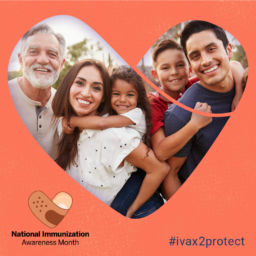May is National Mental Health Awareness Month
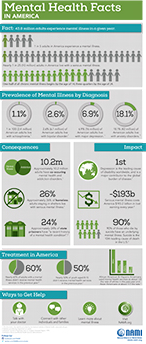
Click on graphic for larger view.
Mental illnesses are common in the United States, affecting one in five adults (46.6 million in 2017) or 18.9% of the adult population. (1) However, due to the stigma attached to experiencing any level of mental impairment, many avoid seeking help and thereby choose to suffer in silence. We need to raise awareness for these conditions and get people the proper treatment necessary for them to lead fully functional, happy and productive lives.
Adults are not the only ones who suffer from mental illness. It is estimated nearly 21% of teenage adolescents will suffer at least one mental illness episode during their life. And 13% of children between 8 and 15 are likely to experience a mental disorder in their life too. (1) Unfortunately, nearly 50% of those affected do not get the proper services or treatment necessary to address their problems.
Mental illness does not discriminate on sex, race or gender either. Those reporting as being two or more races had the greatest reports of mental illness, followed by White, Native Hawaiian, Native American and Black races. Females also have a higher prevalence rate than males.
Those in the LGBQT+ spectrum also report some of the highest mental illness disorders along with substance abuse and suicide ideation. In fact, the transgender population has the highest suicide ideation rate, between 38% and 65%! (2)

https://www.nimh.nih.gov/health/statistics/mental-illness.shtml#part_154785
Now that we have seen the prevalence of mental illness in the United States, let’s see what is classified as a mental illness.
Mental Illness Classifications
According to the National Institute of Mental Health, there are two broad categories of mental health: Any Mental Illness (AMI) and Serious Mental Illness (SMI).
Any Mental Illness (AMI) is defined as a mental, behavioral, or emotional disorder. AMI can vary in impact, ranging from no impairment to mild, moderate, and even severe impairment (e.g., individuals with serious mental illness) (1)
Serious mental Illness (SMI) is defined as a mental, behavioral, or emotional disorder resulting in serious functional impairment, which substantially interferes with or limits one or more major life activities. The burden of mental illnesses is particularly concentrated among those who experience disability due to SMI. (1)
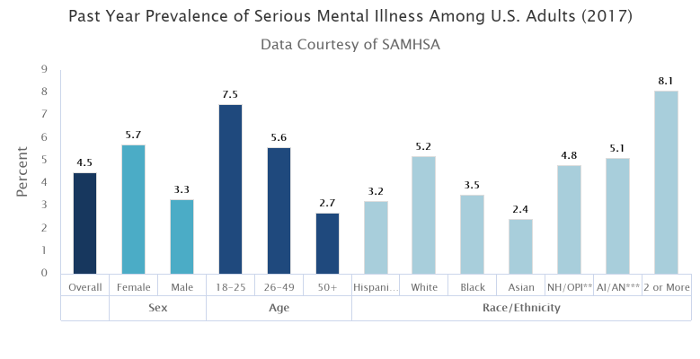
https://www.nimh.nih.gov/health/statistics/mental-illness.shtml#part_154785
What Constitutes Mental Illness
Mental health involves our ability to effectively manage daily activities of productivity, engage in healthy relationships and adapt to changes in our environment through positive coping mechanisms. Many of us experience problems from time to time that are limited in duration and usually resolve themselves with minimum intervention. However, when mood, thinking and behavior issues impair your ability to perform daily activities you may be faced with a mental illness and require professional intervention to help address those issues.
Mental illness is nothing to be ashamed of and requires professional attention just as you would seek for any physical condition. Mental illness is treatable and many people go on to live fully functional and productive lives. The key is to recognize the signs and symptoms, seek professional care and follow the treatment protocol to address the condition(s).
Examples of signs and symptoms include:
- Feeling sad or down
- Confused thinking or reduced ability to concentrate
- Excessive fears or worries, or extreme feelings of guilt
- Extreme mood changes of highs and lows
- Withdrawal from friends and activities
- Significant tiredness, low energy or problems sleeping
- Detachment from reality (delusions), paranoia or hallucinations
- Inability to cope with daily problems or stress
- Trouble understanding and relating to situations and to people
- Alcohol or drug abuse
- Major changes in eating habits
- Sex drive changes
- Excessive anger, hostility or violence
- Suicidal thinking (3)
Mental Illness Disorders
Ther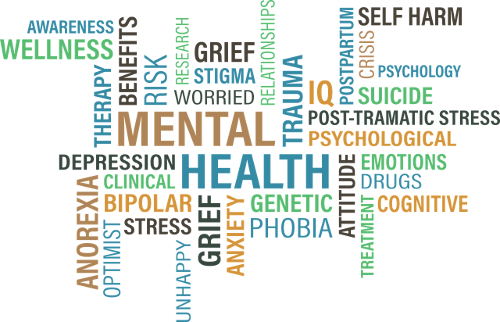 e are seven main groupings of mental illness disorders. Each of them have their own signs and symptoms are often treated by specialists in the mental health profession. Some mental illness disorders may start as physical symptoms, such as stomach troubles, headaches or insomnia, and advance into mental impairments. The effects may be short in duration or could be a lifelong condition requiring ongoing care. Mental illness could also include more than one category of diagnoses and treatment.
e are seven main groupings of mental illness disorders. Each of them have their own signs and symptoms are often treated by specialists in the mental health profession. Some mental illness disorders may start as physical symptoms, such as stomach troubles, headaches or insomnia, and advance into mental impairments. The effects may be short in duration or could be a lifelong condition requiring ongoing care. Mental illness could also include more than one category of diagnoses and treatment.
Examples of mental illness disorders include:
- Anxiety disorders (panic disorder, generalized anxiety disorder, agoraphobia without panic disorder, specific phobia, social phobia, obsessive-compulsive disorder, separation anxiety disorder)
- Mood disorders (major depressive disorder, dysthymia, bipolar disorder I or II)
- Trauma-related disorders (post traumatic stress disorder, abuse)
- Eating disorders (anorexia nervosa, bulimia nervosa, binge-eating disorder)
- Psychotic disorders (schizophrenia)
- Impulse control disorders (oppositional defiant disorder, conduct disorder, attention-deficit/hyperactivity disorder, intermittent explosive disorder)
- Substance use disorders (alcohol and drug abuse and dependence)
Causes of Mental Illness
Mental illnesses can be caused by a variety of genetic and environmental factors:
- Genetic traits – Mental illness can be inherited. Certain genes may increase your risk of developing a mental illness, and generally it is thought a life situation may trigger its occurrence. Do you know a blood relative with a mental illness?
- Environmental (during gestation) – Exposure to chemical substances, such as alcohol, drugs, or toxins can negatively impact a baby’s brain chemistry and development during development in the womb. Repeated stresses and inflammation on the mother’s body could also affect the baby’s brain development in the womb, too.
- Environmental (post birth) – Short-term or longtime exposure to chemicals, toxins, stressful or traumatizing situations, and substance abuse may increase the risk of developing one or more mental illness disorders.
- Brain chemistry – the brain consists of neural networks that use neurotransmitters to communicate information between your brain and its body parts. The chemicals in the neurotransmitters and the neural networks can become impaired, causing dysfunctions, such as depression.
Prevalence of Mental Illness
- Approximately 1 in 5 adults in the U.S. (46.6 million) experiences mental illness in a given year.
- Approximately 1 in 25 adults in the U.S. (11.2 million) experiences a serious mental illness in a given year that substantially interferes with or limits one or more major life activities.
- Approximately 1 in 5 youth aged 13–18 (21.4%) experiences a severe mental disorder at some point during their life. For children aged 8–15, the estimate is 13%.
- 1.1% of adults in the U.S. live with schizophrenia.
- 2.6% of adults in the U.S. live with bipolar disorder.
- 6.9% of adults in the U.S.—16 million—had at least one major depressive episode in the past year.
- 18.1% of adults in the U.S. experienced an anxiety disorder such as posttraumatic stress disorder, obsessive-compulsive disorder and specific phobias.
- Among the 20.2 million adults in the U.S. who experienced a substance use disorder, 50.5%—10.2 million adults—had a co-occurring mental illness. (4)
Social Impacts
- A large percentage of our homeless population are afflicted by mental illness, addictions and disabilities:
- An estimated 26.2% of homeless adults staying in shelters live with serious mental illness.
- An estimated 46% live with severe mental illness and/or substance use disorders (co-occurring disorders).
- Nearly 36.8% (or 4 in 10 adults) have a disability, which is compared to 24.6 percent of
the poverty population and 15.3 percent of the total U.S. population. - Even if those afflicted by these conditions could receive federal support, such Supplemental Security Income
(SSI) or Social Security Disability Insurance (SSDI), it still wouldn’t be enough to provide adequate housing or treatment for their needs. (5)
- More than 2 million people with mental illness are booked into jails (local, state and federal) each year:
- This includes 15% of men and 30% of women who have a serious mental health condition
- A large majority of the non-violent inmates not convicted of a crime suffer from a mental health condition and do not readily have access to healthcare for diagnosis and treatment.
- Up to 83% of jail inmates with a mental illness did not have access to needed treatment.
- Jailing the mentally ill puts unnecessary strain and stress on law enforcement by forcing them to exact discipline on a population not equipped to handle the system. (6)
- More than 70% of juveniles booked into detention facilities were diagnosed with at least one mental disorder
- Of those 70%, 25% were diagnosed with substance abuse issues while 45% were diagnosed with at least one health disorder that did not include a co-occurring addiction issue
- Surprisingly, many juveniles were diagnosed with multiple mental health disorders: 21% with 1 diagnosis, 17% with 2 diagnoses; 19% with 3 diagnoses and 43% with 4 or more diagnoses (7)
Removing Barriers
Stigmas
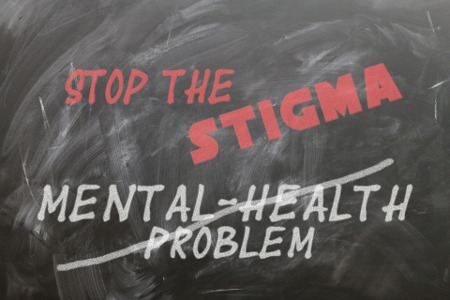 As a nation and global community, we need to remove the negative stigma that surrounds mental health. Just as we seek help addressing a broken body we need to be able to safely and readily seek help for a broken mind.
As a nation and global community, we need to remove the negative stigma that surrounds mental health. Just as we seek help addressing a broken body we need to be able to safely and readily seek help for a broken mind.
Less than 50% of US adults and only 50% of US adolescents with mental health conditions sought help and treatment options for their illness(es) in the past year. Whether it be out of embarrassment, shame, being labeled as weak, fear of losing a job, losing loved ones or friends, or some other stigma, people stopped seeking help, attending counseling or taking medications that could have helped them. Encouraging and creating safe centers of care so people can get the care they need should be our priority.
Another stigma surrounds our jailed population. After release from jail, many people lose access to mental health care and benefits. Once someone has a criminal record it is difficult to secure a job and housing. They may find themselves homeless, using emergency room facilities or even re-incarcerated, thus perpetuating a vicious cycle of mental health collapse. It should be our job to help reintegrate them into society by not only giving essential skills and a sense of self-worth, but to address their disabilities and mental health issues too.
Let’s not forget our daily heroes that serve and protect our communities – our Law Enforcement Professionals, Firefighters and Military personnel. Many of these people see tragedies and horror unfold right in front of them each day, yet they continue to put their lives on the line to serve and protect us. These heroes often appear tough on the outside, but the level of trauma can leave them feeling very vulnerable and distressed internally by these horrific events. They may experience high levels of post traumatic stress disorder (PTSD) or other mental health crises that require immediate attention. However, a false bravado or other stigma indicating weakness could stop these brave men and women from getting the appropriate level of mental health care they need and deserve.
There are quite a few stigmas the LGBQT group experience that often need to be overcome to get them into proper care. The term “minority stress” refers to the vulnerability experienced trying to assimilate into mainstream culture. This minority stress creates barriers that include: “social stigma, discrimination, prejudice, denial of civil and human rights, abuse, harassment, victimization, social exclusion, and family rejection.” (8)
Our collective goal should be to facilitate care when needed, which includes breaking down the barriers to that care. To borrow a quote from our own Declaration of Independence “…that all men are created equal, that they are endowed by their Creator with certain unalienable Rights, that among these are Life, Liberty and the pursuit of Happiness.” (9) This means no matter our age, sex, gender, race or orientation in life, everyone deserves access to quality healthcare to ensure we each can attain a healthy life, exercise our numerous freedoms and find happiness by being a fully functional and productive member of society.
We collectively created these barriers and only we can collectively remove them to ensure everyone has equal access to quality physical and mental healthcare!
Where to Find Care
You do not have to fight (potential) mental illness disorder(s) alone. There are several places you can call or visit to discuss you situation and find assistance with your specific condition.
Emergencies
Some mental illnesses can cause symptoms that may be or appear to be life threatening. These could include suicidal thoughts, heart attacks or breathing issues. If you, your loved one or caregiver feel you need immediate attention, please reach out for help as quickly as possible at:
- Call 911 or your local emergency number immediately
- Call your mental health specialist
- Call the U.S. suicide hotline number — the National Suicide Prevention Lifeline at 1-800-273-TALK (1-800-273-8255)
Specifically for Veterans
The U.S. Department of Veterans Affairs has crisis lines and services established to specifically help our veterans in times of mental crisis. If you are a Veteran in crisis — or you’re concerned about one — free, confidential support is available 24/7. Call the Veterans Crisis Line at 1-800-273-8255 and Press 1, send a text message to 838255, or chat online. (10)
Specficially for the LBGQT+ Community
There are many resources available to help teens, young adults and adults, including the It Gets Better campaign and The Trevor Project, which provides a national, 24-hr, toll-free confidential suicide hotline for LGBTQ youth at 866-488-7386. The Trevor Project also provides an online chat and confidential text messaging—text “Trevor” to 202-304-1200. (2)
National Alliance on Mental Illness (NAMI)
NAMI is an organization dedicated to raising public awareness, providing education and advocacy work in the crafting of public policy for mental health and illnesses. You can find information and references on specific mental illness on the NAMI website along with there WhyCare? campaign to raise awareness.
You can get assistance from NAMI:
- CALL THE NAMI HELPLINE – 800-950-NAMI – M-F, 10 AM – 6 PM ET
- info@nami.org
- FIND HELP IN A CRISIS OR TEXT “NAMI” TO 741741
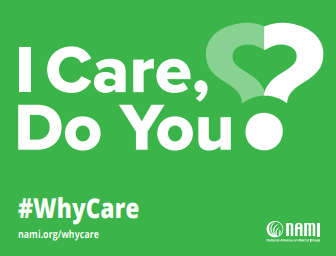 “Care is a simple 4-letter word, but a powerful way to change lives for people affected by mental illness.
“Care is a simple 4-letter word, but a powerful way to change lives for people affected by mental illness.
It’s an action. It’s a feeling. It’s a gift we give to ourselves and to each other. People feel loved when someone cares. People feel heard when someone cares. People recover when someone cares. Society changes when people care. Entire systems change when people care. For more than 40 years, NAMI has been a beacon of help and hope by providing the support, education and advocacy to ensure that all people affected by mental health conditions get the care they need and deserve.
#NAMICares #WhyCare” (11)
May is National Mental Health Awareness Month Summary
Mental health illness is a serious concern and can prevent people from experiencing fulfilling and productive lives. Learn to recognize the signs and symptoms of the disorders associated with mental illness. Then contact a mental health professional for evaluation and a treatment plan.
Some mental illness disorders invoke suicidal thoughts. If you or a loved one is speaking about suicide please get help as soon as possible. See your local mental healthcare counselor or call your local mental health crisis line. You can also call the U.S. National Suicide Prevention line at 1-800-273-TALK (1-800-273-8255).
Several mental illness disorders, including substance abuse issues, start early in the teenage years. However, only 50% of young adults receive evaluation and treatment for these illnesses. Without proper intervention, mental illness will continue to evolve, possibly including more than one disorder in time, so early treatment is paramount in halting progression. We need to ensure our young adult population gets the help they need to grow into fully functional, happy and productive adults!
There are places you can turn to receive care if you, a loved one or someone in your care needs help battling a potential mental illness situation:
- Emergency situations should be addressed by calling 9-1-1 or one of the several hotlines for suicide or mental health crisis
- Seek help from your primary care doctor, your mental health counselor or other health care provider
- Reach out to a close friend or loved one to talk
- Contact a minister, spiritual leader or someone else in your faith community
- Contact your local chaplain if working in law enforcement, fire fighting services or the military
Show people you care by reaching out and helping people get the evaluation and treatment they desperately need. Help break down the barriers that stops people from seeking care. Offer to help any way you can to demonstrate you care about their health and improving the quality of their life. Advocate for healthcare access for all despite their age, sex, gender, race, or socio-economic status.
Remember, there is no shame in seeking treatment for a mental health condition. In fact, mental illness is treatable and many people go on to live fully functional, happy and productive lives. The key is learning the signs and symptoms and then seek the appropriate treatment to address the level of mental illness! Don’t let stigmas and barriers stop you from getting the necessary help you need to be the best version of yourself!
To your improved (mental) health!
References:
- (1) National Institute of Mental Health – Mental Illness
- (2) National Alliance on Mental Illness – LGBQT
- (3) Mayo Clinic – Mental Illness
- (4) National Alliance on Mental Illness – Mental Health by the Numbers
- (5) U.S. Department of Housing and Urban Development, Office of Community Planning and Development – 2010 Annual Homeless Assessment Report (AHAR)
- (6) National Alliance on Mental Illness – Jailing People With Mental Illness
- (7) National Center for Mental Health and Juvenile Justice – Blueprint for Change: A Comprehensive Model for the Identification and Treatment of Youth with Mental Health Needs in Contact with the Juvenile Justice System
- (8) Thrivetalk – LGBT and Mental Health Treatment: Learning to Trust Your Therapist
- (9) USHistory.org – Declaration of Independence
- (10) US Department of Veterans Affairs – Mental Health
- (11) National Alliance on Mental Illness – Why Care?

